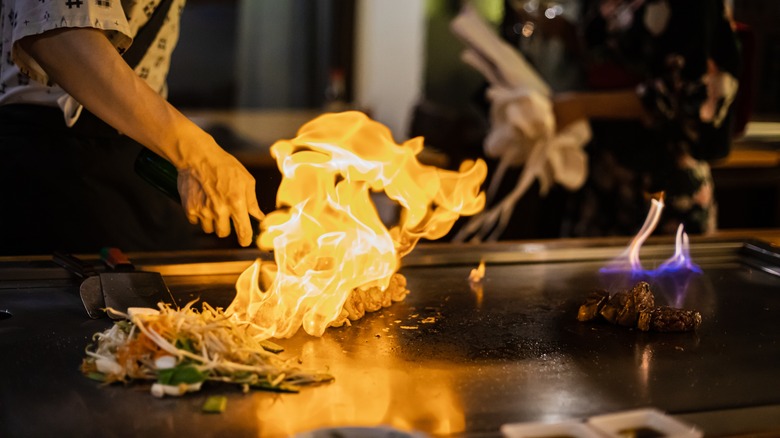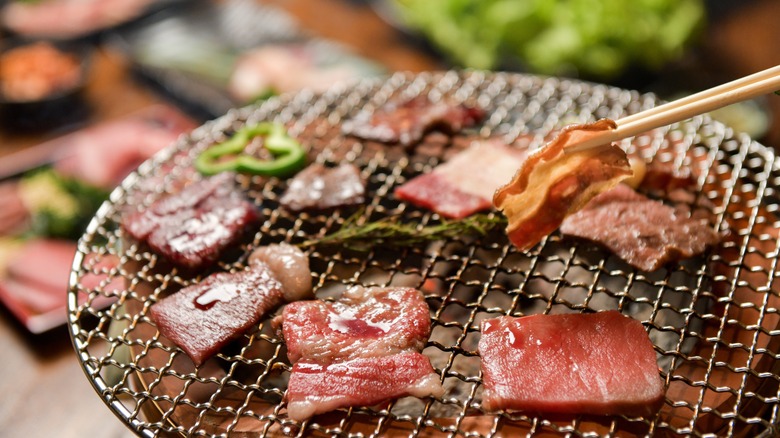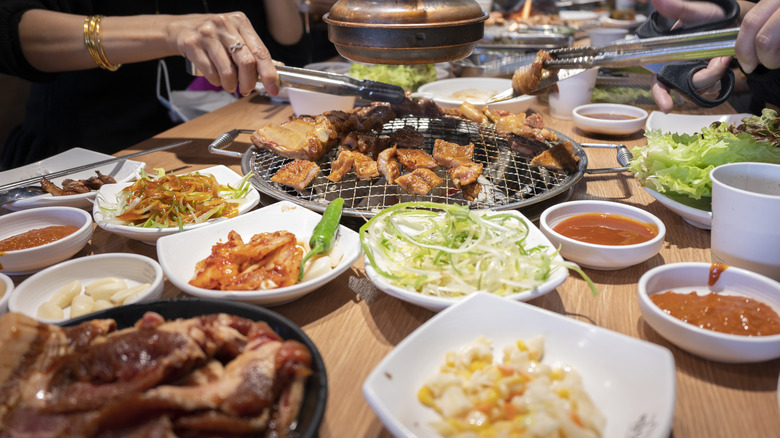Korean Vs Japanese Barbecue: What Is The Difference?
Mankind certainly has an affinity for food cooked directly over fire, and this is apparent in the popularity of barbecue around the globe. Here in the U.S. we have several styles of barbecue that vary from state to state, and there is an entire world out there of delicious, flame-broiled goodness. To name a few, there's Brazilian churrasco, Indian tandoor, and several types of barbecue throughout Asia, including Japanese and Korean styles. Delicious in their own right, these last two are often mistaken for one another, and while they share some similarities, there are several differences that make them distinct.
Despite the fact that Japanese and Korean barbecue are cooked indoors on a special table that has a grill on it for communal cooking and eating, each style differs in the way it is prepared, how it is flavored, and how it is served. Japanese and Korean barbecue are further separated into various subtypes. For example, three popular styles of Japanese grilling include teppanyaki, hibachi, and yakiniku. As for Korean barbecue, galbi and bulgogi are two beloved iterations that many are familiar with.
What is Japanese barbecue?
Sitting down to a Japanese teppanyaki meal means your food will be prepared on a large, flat, iron griddle. Americans often misidentify this as hibachi style cooking, but authentic hibachi is cooked on a heated surface that is much smaller than a teppanyaki grill. In both cases, the food is not cooked over direct heat (or flame), but rather, on a hot plate, usually heated by propane. Japanese yakiniku, however, is cooked over a charcoal grill that is lowered into the middle of a dining table, making it similar to Korean barbecue, which we'll get to in a minute.
While you can find chicken and even shrimp in Japanese barbecue joints, it's beef that is the real star of the show, and this cuisine likes to highlight the flavor of the proteins themselves. With that said, pre-marinating meat is minimal; instead, dipping sauces often accompany the cooked meats (and vegetables, if they are present). These typically include garlic, soy sauce, and the sweet flavored rice wine known as mirin. If you order chicken at a Japanese barbecue restaurant, it often comes skewered while steak does not.
What is Korean barbecue?
Meanwhile, the barbecue from Korea is often identified as either galbi or bulgogi, which are both grilled over direct heat on charcoal grills that are set into a communal dining table. Diners tend to see plenty of beef in Korean barbecue and some chicken, but also much more pork, which is minimal in Japanese barbecue. With galbi style, boneless beef short ribs are common. On the other hand, beef tenderloin and sirloin are popular choices in bulgogi barbecue. Whereas Japanese barbecue relies on dipping sauces to flavor its grilled meats, marinades are heavily used in Korean barbecue.
As for what to expect when you visit a Korean restaurant, cooked meat is sometimes served with lettuce leaves, which can be made into a bundle using the barbecue, along with a selection of banchan. Banchan are small dishes of accompaniments that are designed to be eaten in tandem with Korean barbecue and can include things like cucumber salad, kimchi, and soybean sprouts. The more banchan on the table, the more flavors there are to discover in any given Korean barbecue meal.
With both Japanese and Korean styles of barbecue, you can expect a flavorful and exciting meal, despite the fact that it's very different from the Kansas City ribs or Alabama white sauce chicken you might be used to. And these two are just the beginning; the rest of Asia is brimming with many more grilled delights from places like Taiwan, China, and the Philippines.


